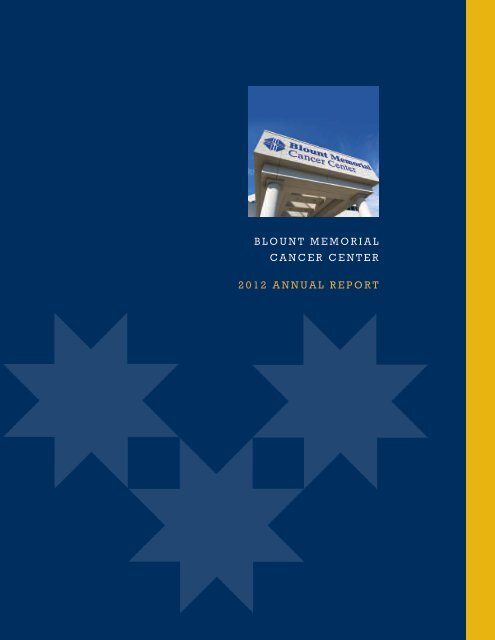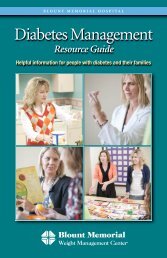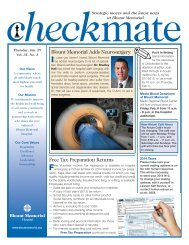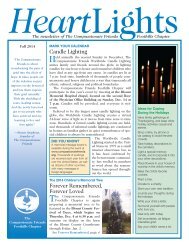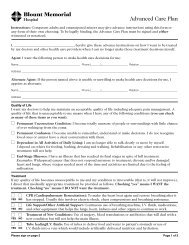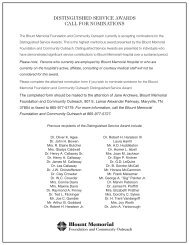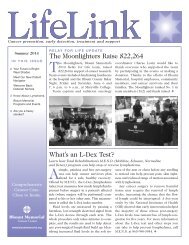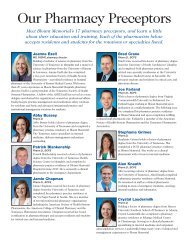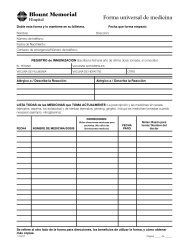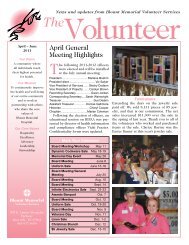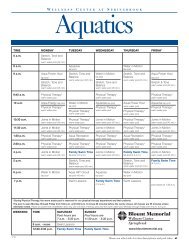2012 Cancer Center Annual Report - Blount Memorial Hospital
2012 Cancer Center Annual Report - Blount Memorial Hospital
2012 Cancer Center Annual Report - Blount Memorial Hospital
- No tags were found...
You also want an ePaper? Increase the reach of your titles
YUMPU automatically turns print PDFs into web optimized ePapers that Google loves.
B L O U N T M E M O R I A LC A N C E R C E N T E R2 0 1 2 A N N U A L R E P O R T
VISIONA COMMUNITYWHERE ALL INDIVIDUALSREACH THEIR HIGHEST POTENTIALFOR HEALTH.MISSIONTO CONTINUOUSLY IMPROVE THE HEALTH ANDWELL-BEING OF OUR ENTIRE COMMUNITY AND TOWORK IN PARTNERSHIP WITH OTHERS WHO SHARETHE CORE VALUES OF BLOUNT MEMORIAL HOSPITAL.HOSPITALITY l EXCELLENCE l ADVOCACY l LEADERSHIP l STEWARDSHIP
I would encourage you to review the full report to read thepatient stories, see the positive results of our prostate cancerprogram as documented in this year’s study and learn a bitmore about your community <strong>Cancer</strong> <strong>Center</strong>. As you will see,everyone involved with the <strong>Cancer</strong> <strong>Center</strong> is focused on onegoal: achieving the best-possible outcomes for every patient.This includes promoting awareness of cancer preventionand early detection, as well as providing support to cancersurvivors and those undergoing treatment.We welcome your questions and appreciate your interestand support. Together, we are bringing state-of-the-art cancercare home to <strong>Blount</strong> County.Sincerely,Dr. Albert PettyRadiation oncologist and <strong>Cancer</strong> <strong>Center</strong> medical director
“DR. PETTY’S PHILOSOPHY IS:‘IF YOU HAVE A QUESTION, JUSTASK.’ THEY ALWAYS DID THEIRBEST TO ANSWER MY QUESTIONSAND TO LET ME KNOW WHATWAS GOING TO HAPPEN. I HAVEAN INSATIABLE CURIOSITY, SO IWONDERED ABOUT THE NUTSAND BOLTS OF THE TREATMENT.”Beem visited the <strong>Cancer</strong> <strong>Center</strong> every weekday for abouttwo months to complete his 44 radiation treatments. Whilehe says the entire experience was “as positive as possible,”Beem was most appreciative of the staff ’s willingness toanswer all of his questions.He explains, “Dr. Petty’s philosophy is: ‘If you have aquestion, just ask.’ They always did their best to answer myquestions and to let me know what was going to happen. Ihave an insatiable curiosity, so I wondered about the nutsand bolts of the treatment. Dr. Petty took the time toexplain everything to me in a way I could understand,which made me a happy camper.”Now that Beem is finished with his treatment andcancer-free, he’s looking forward to traveling again with hiswife, Gwen. The Maryville residents have a motor homeand enjoy hitting the open road to visit National Parks andmonuments, participate in service mission trips with theChilhowee Baptist Association, and spend time with outof-staterelatives and friends. Wherever his future travelslead him, Beem says he will always make time for hisannual physical and recommended health screenings.“If there was one message I could get across to anyman reading this it’s that you need to look after yourselfbecause no one is going to do it for you,” Beem adds.“There’s no excuse. Most of these preventive tests arecovered by insurance, and the prostate screening is simple.Why wait until it’s too late?”B L O U N T M E M O R I A L C A N C E R C E N T E R ●2 0 1 1 A N N U A LR E P O R T ● 8
“I KNEW THAT BLOUNT MEMORIALWAS ONE OF THE BEST PLACES TO GOFOR CANCER TREATMENT. WITH MYDAUGHTER’S HELP, IT WAS SO EASY TO GETTHERE BECAUSE I LIVE IN BLOUNT COUNTY.I HAD TO GO FOR SEVEN-AND-A-HALFWEEKS, AND WAS SO HAPPY WHEN I GOT TORING THE BELL SIGNALING THAT I WASDONE WITH MY TREATMENT.”THE BLOUNT MEMORIALCANCER CENTER WELCOMEDRADIATION ONCOLOGISTDR. DANIEL GREEN IN NOVEMBER.Dr. Green, who most recently worked at theUniversity of Tennessee Medical <strong>Center</strong>, holdsa medical degree from the Vanderbilt UniversitySchool of Medicine, as well as a bachelor of artsdegree in biochemistry from Brown University inProvidence, R.I. After medical school, Greencompleted an internal medicine internship andresidency at Dartmouth-Hitchcock Medical <strong>Center</strong>in Hanover, N.H., as well as a radiation oncologyresidency through Duke University Medical<strong>Center</strong> in Durham, N.C. Green also completeda hematology and medical oncology fellowshipat Dartmouth-Hitchcock Medical <strong>Center</strong>.
1 1 ● B L O U N T M E M O R I A L C A N C E R C E N T E R ● 2 0 1 2 A N N U A L R E P O R TMOST COMMONLY TREATED CANCERSIncidence Rates 1 , Screening Guidelines and Warning Signs15 13 1417 17 14 10 14 15BREAST CANCERBreast cancer is the most commonnon-skin cancer in the United Statesand the second-leading cause of cancer-relateddeath in American women.Women can help detect breast cancerin its earliest, most-treatable stagesby following three steps:Get a yearly mammogram beginningat age 40 and continuing for as longas they are in good health.Have a clinical breast exam everythree years in their 20s and 30s andevery year from age 40 on.Perform a monthly breast self-exam,and report any breast changes to theirhealth care provider.Symptoms may include:• a change in how the breast ornipple feels• a lump or thickening in or near thebreast or in the underarm area• nipple tenderness• a change in how the breast ornipple looks• a change in the size or shape ofthe breast• a nipple turned inward into thebreast• scaly, red or swollen skin on thebreast, areola or nipple that mayhave ridges or pitting so that it lookslike the skin of an orange• fluid discharge from the nippleLUNG CANCERMore people in the United States dieeach year from lung cancer than fromcolon, breast and prostate cancerscombined. Cigarette smoking is theleading cause of the disease, however,genetic and environmental factorsalso may play a role. While earlylung cancer often does not causesymptoms, the conditions listed belowcould indicate cancer or anotherserious health problem. Tell yourdoctor if you experience:• a cough that gets worse or doesnot go away• breathing trouble, such asshortness of breath• constant chest pain• coughing up blood• a hoarse voice• frequent lung infections,such as pneumonia• feeling very tired all the time• weight loss with no known causePROSTATE CANCERProstate cancer is the second-leadingcause of cancer death for men in theUnited States. If detected early,however, minimally invasive optionsusually can treat the cancer andrestore body function. Early prostatecancer typically causes no symptoms.To help protect their prostate health,men should follow three steps:Schedule an annual physical examwith a health care provider.At age 40 and older, ask their doctorsabout the benefits and risks of having aprostate-specific antigen (PSA) bloodtest and digital rectal exam (DRE) toscreen for prostate cancer.Watch for potential warning signs,including:• difficulty urinating• decreased force in the streamof urine• blood in the urine• blood in the semen• swelling in the legs• discomfort in the pelvic area• bone painSource: American <strong>Cancer</strong> Society. <strong>Cancer</strong> Facts and Figures. Atlanta: American <strong>Cancer</strong> Society: 20111 Information from the 2011 <strong>Blount</strong> <strong>Memorial</strong> Tumor Registry Data.2 <strong>Blount</strong> <strong>Memorial</strong>’s prostate cancer incidence may be lower due to many patients being diagnosed and treated in physician offices.
B L O U N T M E M O R I A L C A N C E R C E N T E R ● 2 0 1 2 A N N U A L R E P O R T ● 1 2COMPARING CANCER INCIDENCE RATESThe charts below show the incidence rates (in percent)of the six most commonly diagnosed cancers during 2011 and comparesthose rates between the <strong>Blount</strong> <strong>Memorial</strong> <strong>Cancer</strong> <strong>Center</strong> and those ofother hospitals in the state of Tennessee and nationally.BLOUNT MEMORIALCANCER CENTER 5STATE OF TENNESSEE 4UNITED STATES 38 9 9COLORECTAL CANCERColorectal cancer is the third-leadingcause of cancer death in both menand women in the United States, yetit is preventable and highly treatablewhen detected early. Routine screeningscombined with healthy eating andlifestyle habits help save lives. Beginningat age 50, both men and womenshould get screened for colorectalcancers following one of these testingschedules:*• Flexible sigmoidoscopyevery five years• Colonoscopy every 10 years• Double-contrast barium enemaevery five years• CT colonography (virtualcolonoscopy) every five yearsSymptoms may include:• having diarrhea or constipation• feeling that your bowel does notempty completely• finding blood (either bright redor very dark) in your stool• finding your stools are narrowerthan usual• frequently having gas pains orcramps, or feeling full or bloated• losing weight with no known reason• feeling very tired all the time• having nausea or vomiting7 4 4BLADDER CANCERMore than nine out of 10 Americanswith bladder cancer have a typecalled transitional cell cancer, whichbegins in the inner lining of thebladder (the organ that stores urine).In <strong>2012</strong>, about 56,000 men and18,000 women (most over age 70)were diagnosed with bladder cancerin the United States.Signs of bladder cancer can include:• blood in the urine (which may makethe urine look rusty or darker red)• experiencing an urgent need toempty the bladder• having to empty the bladder moreoften than before• feeling the need to empty thebladder without results• straining to empty the bladder• pain when urinatingIf you experience any of thesesymptoms, see your health careprovider for timely diagnosis andtreatment. The underlying cause couldbe bladder cancer, infection or anotherhealth problem.4 5 5MELANOMAMost skin cancers are curable ifdetected early, and not all skinchanges are cancerous. Melanomais the most dangerous type of skincancer and also can involve thecolored part of the eye. It is theleading cause of death fromskin disease.Use the ABCDE system to help determineif moles or other skin changescould be symptoms of melanoma:• asymmetry: one half of theabnormal area is different from theother half.• borders: the edges of the growthare irregular.• color: color changes from one areato another, with shades of tan,brown or black, and sometimeswhite, red or blue.• diameter: the spot is usually(but not always) larger than the sizeof a pencil eraser.• evolution: the mole keeps changingappearance.* Your physician may recommend earlier and/ormore frequent screenings.3 Percent is based on a total of 1,596,670 new cancer diagnoses for the United States in 2011.4 Percent is based on a total of 34,750 new cancer diagnoses for the state of Tennessee in 2011.5 Percent is based on a total of 579 new cancer diagnoses for the <strong>Blount</strong> <strong>Memorial</strong> <strong>Cancer</strong> <strong>Center</strong> in 2011.
1 3 ● B L O U N T M E M O R I A L C A N C E R C E N T E R ● 2 0 1 2 A N N U A L R E P O R TCOMPREHENSIVE COMMUNITYCANCER PROGRAMPrevention, diagnostics,treatment and support<strong>Blount</strong> <strong>Memorial</strong>’s cancer care program isapproved by the American College of SurgeonsCommission on <strong>Cancer</strong> (CoC). Receiving careat a CoC-accredited cancer program hospital orfacility ensures that patients will receive:comprehensive care including a complete range ofstate-of-the-art services and equipmentEMILY BROOKS,LICENSED MASTER SOCIAL WORKER“I BELIEVE THAT PROVIDINGONCOLOGY SOCIAL WORK SERVICESIS AN EXTREMELY IMPORTANT PIECE OFPROVIDING THE HIGHEST QUALITY,COMPREHENSIVE CARE TO OUR PATIENTSAND THEIR FAMILIES. CANCER DOESN'TJUST AFFECT PEOPLE IN A PHYSICAL SENSE.THERE ARE EMOTIONAL, MENTALAND SPIRITUAL IMPACTS.a team approach to coordinate the bestavailable treatment optionsinformation about ongoing cancer clinical trialsand new treatment optionsaccess to prevention and early detection programs,cancer education and support servicesa cancer registry that offers lifelong patient follow-upongoing monitoring and improvements in cancer care,close to homeCANCER CARE TEAMMultidisciplinary experts work together toachieve the best-possible outcomes. The<strong>Blount</strong> <strong>Memorial</strong> cancer care specialistsinclude dedicated physicians, surgeons, medical oncologists,nurses, therapists, dietitians, social workers, pharmacistsand lab technicians, plus the staffs of radiation oncology,pathology, pulmonology, radiology, Home Services, Counselingand CONCERN, Hospice and Palliative Care, andthe Breast Health <strong>Center</strong>.A tumor conference team, comprised of experts fromsome of the same clinical areas of the hospital, meets weeklyto discuss current and new cancer patients’ cases. Throughdiscussion with physicians of different specialty areas, suchas oncology, surgery, radiology and pathology, the grouprecommends the most appropriate treatment.In addition to hospital staff and employees, helpful<strong>Blount</strong> <strong>Memorial</strong> volunteers welcome visitors upon arrivalat the <strong>Cancer</strong> <strong>Center</strong>, and are available to answer questionsand give directions.Site-specific cancer physicians include pathologists,radiation oncologists, radiologists, surgeons and surgicaloncologists, plus:Breast cancerColorectal cancerLung cancerLymphomaProstate cancerSkin cancergynecologists, obstetricians/gynecologists and plastic surgeonsgastroenterologistspulmonologists andcardiothoracic surgeonshematologistsurologistsdermatologists and plastic surgeons
B L O U N T M E M O R I A L C A N C E R C E N T E R ● 2 0 1 2 A N N U A L R E P O R T ● 1 4ONCOLOGY SOCIAL WORKSERVICES GROWPsychosocial support services helppatients deal with the emotional, familyand practical problems that can occur in dealing witha chronic illness such as cancer. At the <strong>Cancer</strong> <strong>Center</strong>,these “oncology social work” services traditionally havebeen focused on radiation oncology patients. Early in2013, the <strong>Cancer</strong> <strong>Center</strong> will expand the program toinclude outpatient infusion patients.“<strong>Cancer</strong> doesn't just affect people in a physical sense,”says <strong>Cancer</strong> <strong>Center</strong> oncology social worker EmilyBrooks. “There are emotional, mental and spiritual impacts.Our patients have concerns beyond their scans or labresults. They worry about their relationships, about tellingtheir children they have cancer, about their finances andinsurance, and about how they are going to findtransportation to their treatments.”Patients referred to the <strong>Cancer</strong> <strong>Center</strong> for treatment receivean assessment to identify individual and family needs.Based on the results, social workers answer questions,offer emotional and educational support, identify availablecommunity resources and provide limited notary servicesrelated to Advance Directive documents.For more information about the oncology social workprogram, call Brooks at 865-980-5055.PERSONALIZED CARETreating people with cancer requiresspecialized training and knowledge,as well as compassionate, one-on-one monitoring.INPATIENT<strong>Blount</strong> <strong>Memorial</strong> offers an oncology floor on 5-east in themain hospital. Experienced registered nurses—manyof whom are oncology-certified—provide both inpatientand outpatient cancer care. Outpatient treatmentsadministered here include infusion therapy for peoplewhose treatment involves chemotherapy, blood products,intravenous medicines and fluids.The 18,062-square-foot area features 26 spacious patientrooms and is staffed by specially trained oncology nurseswho provide one-on-one monitoring. An outpatienttreatment area featuring comfortable recliners andhospital beds and an inpatient nursing unit includingthree negative pressure rooms, also called airborne infectionisolation rooms, are located in this area. The 5-eastfloor also includes spacious waiting areas for patients’family members, as well as quiet, private areas forconfidential family and staff consultations.OUTPATIENTThe <strong>Cancer</strong> <strong>Center</strong>’s radiation oncology departmentfollows a high-tech, high-touch approach, combining themost-advanced treatment technologies with a welcoming,patient-centered environment. Registered radiationtherapists administer physician-directed treatment andtake the time to answer patient and family questions,explain treatment plans, and offer support andsuggestions in dealing with side effects.
1 5 ● B L O U N T M E M O R I A L C A N C E R C E N T E R ● 2 0 1 2 A N N U A L R E P O R TBLOUNT MEMORIAL CANCER CENTEREnhanced ServicesContinuous improvement ensures that the <strong>Cancer</strong> <strong>Center</strong>delivers leading-edge diagnostics, treatments and supportservices to people with cancer. Here’s a brief overview ofsome of the ways we expanded our capabilities in <strong>2012</strong>to provide the best-possible care.WELCOMING EAST TENNESSEE’S BEST CHEST SURGEONSIn <strong>2012</strong>, <strong>Blount</strong> <strong>Memorial</strong> partnered with the University of Tennessee Medical <strong>Center</strong> Thoracic Surgeonsto offer state-of-the-art cardiothoracic diagnostics, treatment and procedures. Local patients requiringchest surgery or any cardiothoracic treatment, can request a physician referral to their location in the<strong>Blount</strong> <strong>Memorial</strong> Physician Office Building. Free parking and shuttle service are available in the hospital’s parkinggarage and visitor lots. Meet the University of Tennessee Medical <strong>Center</strong> Thoracic Surgeons at <strong>Blount</strong> <strong>Memorial</strong>.Dr. Raymond Dieter IIICardiothoracic SurgeryAmerican Board of Surgery,Thoracic Surgery; Member:American Society of ThoracicSurgeons, American College ofSurgeons and InternationalCollege of SurgeonsDr. Jeffrey EverettCardiothoracic SurgeryAmerican Board of Surgery,Thoracic Surgery; Member:Society of Thoracic Surgeons,American College of Surgeons,American College of ChestPhysicians, International Societyof Heart and Lung Transplantationand AmericanMedical AssociationDr. Thomas GainesCardiothoracic SurgeryAmerican Board of Surgery,Thoracic Surgery; Member:Society of Thoracic Surgeons,American College of Surgeons,American College of ChestPhysicians, Tennessee MedicalAssociation and KnoxvilleAcademy of MedicineDr. John MackCardiothoracic SurgeryAmerican Board of Surgery,Thoracic Surgery; Member:Society of Thoracic Surgeons,American College of Surgeonsand Southern Thoracic SurgeryAssociationMichelle McPherson<strong>Blount</strong> <strong>Memorial</strong> registerednurse and thoraciccoordinator
PERFECT FITSPECIALTY SHOPIn February, a full-service,specialty shop offeringpost-mastectomy andlymphedema accessories,supplies and adaptive clothingopened on the secondfloor of the <strong>Cancer</strong> <strong>Center</strong>.The name, Perfect Fit, mirrorsthe store’s mission, which ishelping women and men who are undergoing or who havehad cancer treatment or other health complications lookand feel confident and comfortable. Perfect Fit hascertified mastectomy fitters (CMF) on staff and offersmastectomy bras, mastectomy swimsuits, full breast prosthesesand partial shapers, wigs and headwear (includinghats, scarves and turbans), as well as lymphedema items.Monday-Friday, 8:30 a.m. – 5 p.m.Phone: 865-980-5077M.E.N.D. PROGRAM EXPANDS<strong>Blount</strong> <strong>Memorial</strong>’s M.E.N.D. (Mobilize, Educate, Normalizeand Detect) rehabilitation program continues to expand.Initially, the program was focused primarily on lymphedema,a disabling and painful conditioncaused by the build-up of lymphfluid in the soft tissues of the limbs.M.E.N.D.’s highly specialized, complexdecongestive therapy helpsrestore proper lymph function andrange of motion in areas affected byscar tissue, radiation or surgery.As part of an ongoing effort toaddress the rehabilitation needs ofall cancer survivors, M.E.N.D. has added specialized speechlanguagepathology services. According to speech-languagepathologist Becky Martin, people often experience forgetfulnessand lapses in concentration when undergoing chemotherapyor other cancer treatments. M.E.N.D.’s pre- andpost-treatment speech therapy is designed to help patientsretain memory and concentration skills, and to developcompensatory strategies, such as keeping a daily journal,establishing a routine and staying organized.M.E.N.D. services are not limited to people who arebeing treated for cancer. Additional capabilities include:• addressing musculoskeletal problems and pain aftersurgery and nerve irritability from chemotherapy andradiation• treating non-cancerous swelling related to chronicvenous insufficiency, joint replacement surgery,orthopedic injury, recurring leg wounds or othermedical problems• speech-language pathology to prevent or treat speech,swallowing skills, and head and neck movement relatedto surgery and radiation• free, early detection testing and follow-up for newlydiagnosed cancer patients to help prevent lymphedemaA physician referral is required for all M.E.N.D.services. For more information, call M.E.N.D.at 865-980-5044 or visit www.blountmemorial.org.
1 7 ● B L O U N T M E M O R I A L C A N C E R C E N T E R ● 2 0 1 2 A N N U A L R E P O R TCOMMUNITY OUTREACHPromoting cancer awareness andprevention through education,screenings and supportThe healing reach of the <strong>Cancer</strong> <strong>Center</strong> extends into thecommunity through a variety of programs and special events.Physicians, staff and employees host cancer education, preventionand support programs at the center, as well as participate in teamevents and screenings in the community. Community outreach efforts help support survival by promotingawareness of cancer risk factors, symptoms, diagnostics and treatment. Here’s a quick overview of the<strong>Cancer</strong> <strong>Center</strong>’s community outreach programs and participants in <strong>2012</strong>.COMMUNITY OUTREACH BY THE NUMBERSEducation/Support GroupsLifeStoriesLife PreserversM.E.N.D. Support GroupLunch and LearnHealth Fairs/Health ScreeningsSkin <strong>Cancer</strong> ScreeningHead and Neck ScreeningHealth FairsMammogramsin the Moonlight andMammograms in MayCommunity or School PresentationsSafari SamOther communitypresentationsStudent MentoringRadiation therapistcertificate program58 participants116 participants129 participantsmore than 200 participants56 participants6 participantsmore than 2,700 attendees39 participants228 attendees210 participantsTotal number of encounters: 58Total number of participants: 4,7141 studentapproximately 840 hoursThe <strong>Blount</strong> <strong>Memorial</strong> <strong>Cancer</strong> <strong>Center</strong>offers these education, fellowshipand support group opportunitiesfor patients and families:CAREGIVER SUPPORT GROUPFor more information, call 865-977-5744.Wednesdays of each month, 7-8 p.m.<strong>Blount</strong> <strong>Memorial</strong> <strong>Hospital</strong>, 3-eastCANCER CARE: MANAGING YOUR CANCERThis informative class is designed to teach newlydiagnosed cancer patients and their families or caregiversabout managing their cancer with a special focus onchemotherapy administration and its side effects.For more information or to register, call 865-256-8576.Second and fourth Tuesdays of each month, 1-4 p.m.<strong>Blount</strong> <strong>Memorial</strong> <strong>Hospital</strong>, 5-east classroomLOOK GOOD, FEEL BETTERThis national program is dedicated to teaching womenwho are cancer patients the techniques to help restore theirappearance and self-image. You are invited to attend anyone session free of charge, providing you are currentlyreceiving either chemotherapy or radiation therapy atany hospital. A light lunch is provided. To register, callthe <strong>Blount</strong> <strong>Memorial</strong> <strong>Cancer</strong> <strong>Center</strong> at 865-977-5534.Meets the first Monday of each month, 10 a.m. – noon,<strong>Blount</strong> <strong>Memorial</strong> <strong>Cancer</strong> <strong>Center</strong> radiation oncologyconference room, first floor
I CAN COPEThis national American <strong>Cancer</strong> Society program, facilitatedby the <strong>Blount</strong> <strong>Memorial</strong> <strong>Cancer</strong> <strong>Center</strong>, helps cancerpatients and their friends or family members who aredealing with cancer and its side effects. For moreinformation or to register, call 865-977-5534.LIFESTORIESPreserve your memories by scrapbooking in this monthlyart therapy program. This support group is for cancerpatients, survivors and their families. All supplies arefurnished. Participants should bring the photos they wishto use. A light lunch is provided. For more information orto register, call 865-977-5534. Third Monday of eachmonth, 9 a.m. – 1 p.m., <strong>Blount</strong> <strong>Memorial</strong> <strong>Cancer</strong> <strong>Center</strong>conference room 2, second floorLUNCH AND LEARNThis <strong>Cancer</strong> <strong>Center</strong>-related health education programis for the community. For more informationor to register, call 865-980-5038.LYMPHEDEMA SUPPORT GROUPA support group for lymphedema patients that focuseson home therapy and management techniques. A mealis provided. For more information or to register, call865-980-5044. <strong>Blount</strong> <strong>Memorial</strong> <strong>Cancer</strong> <strong>Center</strong>conference room 1 and 2, second floorTHE LIFE PRESERVERSLife Preservers capture life’s special moments throughscrapbooking. Your membership fee is tax-deductible andproceeds go to the <strong>Blount</strong> <strong>Memorial</strong> Foundation’s <strong>Cancer</strong><strong>Center</strong> Patient Resource Fund, which serves cancerpatients and their families who struggle with financesduring their diagnosis and treatment. To registeror for more information, call 865-977-5534.Third Saturday of each month, 9 a.m. – 6 p.m.,<strong>Blount</strong> <strong>Memorial</strong> <strong>Hospital</strong> auditoriumCost: $20/month; $150/yearFREE HEAD ANDNECK CANCER SCREENINGSTennessee has one of the highest tobaccouse rates in the country, so finding ways toprevent head and neck cancers is a pressingpublic health issue. The <strong>Cancer</strong> <strong>Center</strong> hosted a freescreening in May and <strong>Blount</strong> <strong>Memorial</strong> otolaryngologistDr. Bond Almand donated his time to conduct the screenings.People who missed the screening are encouraged tosee their physician if they notice any of these potential headand neck cancer symptoms:• a lump or sore that does not heal• a sore throat that does not go away• trouble swallowing• a change or hoarseness in the voiceTo schedule an exam with a <strong>Blount</strong> <strong>Memorial</strong> physician,call the Physician Referral Line at 865-981-3983.EARLY LUNG CANCERSCREENING PROGRAMEarly screenings can help detect andprevent lung cancer in people whosmoke(d) heavily. This year, <strong>Blount</strong> <strong>Memorial</strong> introduced anew program using low-dose spiral computed tomography(CT) scans to identify small lung cancers in the earliest,most treatable stages. Lung cancer screenings areavailable to adults aged 55-74 who:• are current heavy smokers with a smoking historyof 30 years (either one pack per day for 30 yearsor two packs per day for 15 years)• are former heavy smokers who have quit smokingwithin the last 15 years• have no previous diagnosis of lung cancer, pulmonarynodules or related symptoms such as shortness ofbreath, unusual or persistent chest or back pain,and coughing up blood• have not undergone a chest CT within the last 18 months• have a written order from a physician or other healthcare providerWant to schedule a screening? Lung cancer screeningsare conducted at the <strong>Blount</strong> <strong>Memorial</strong> Diagnostic <strong>Center</strong> atSpringbrook and at East Tennessee Medical Group. Thetests are self-pay (no insurance or Medicaid accepted) for$375. Payment is due at the time of screening. Cash,checks and credit cards are accepted. For more informationor to schedule a screening, call the <strong>Blount</strong> <strong>Memorial</strong>radiology department at 865-981-2288 or EastTennessee Medical Group at 865-268-1320.
1 9 ● B L O U N T M E M O R I A L C A N C E R C E N T E R ● 2 0 1 2 A N N U A L R E P O R TBLOUNT MEMORIAL FOUNDATIONSupporting survivalby assistingcancer patientsLiving with a cancer diagnosiscan be physically, emotionallyand financially draining.To help ease a bit of the financial burdenfaced by our neighbors with cancer,the <strong>Blount</strong> <strong>Memorial</strong> Foundation offersa variety of cancer-related givingopportunities and funds.ASSISTANCE TO CANCER PATIENTSFROM THE BLOUNT MEMORIAL FOUNDATIONrepresents more than $32,000 in assistance during <strong>2012</strong>More than $4,200 gas vouchers to assist patients incoming to and from treatmentMore than $2,500 in grocery vouchersPaid more than $3,000 in utility bills—gas, electric, waterProvided more than $1,200 in medications and over$800 in medical equipment—oxygen, infusion, etc.Supplied more than $1,000 in snacks to cancer patientsin the <strong>Cancer</strong> <strong>Center</strong>Provided $450 in counseling services to cancerpatients needing that service in coping withtheir diagnosisProvided $1,750 for professional development foroncology staff including nursing and social workersThrough the Project HOPE fund, administered more than$20,000 in assistance to breast cancer patients in the16-county area served by the Knoxville affiliate ofSusan G. Komen for the Cure.CANCER CENTER PATIENT RESOURCE FUNDThe <strong>Blount</strong> <strong>Memorial</strong> Foundation’s Patient Resource Fundserves cancer patients and their families who are strugglingwith finances during their diagnosis and treatment. Funds areused to purchase gas and grocery vouchers, provide financialassistance with medications and utility bills, and cover otherbasic expenses to help maintain quality of life.Donations from individuals, businesses, foundations and hospitalemployees, as well as proceeds from various Foundationevents, help support the fund and other Foundation programs.SUPPORTING SURVIVALBreast <strong>Cancer</strong> Patient Resource FundWomen diagnosed with breast cancer face tremendous physical,emotional and financial challenges. While each of thesefactors can be overwhelming, it is the financial burden that cancause undue stress at a time when the patient needs to focuson hope, health and healing.To help ease this burden, eligible <strong>Blount</strong> County breast cancerpatients can apply for financial assistance. Patients who liveoutside of <strong>Blount</strong> County, but who are receiving treatmenthere, also are eligible to apply.Breast cancer patients who may be eligibleto receive assistance should call the <strong>Blount</strong><strong>Memorial</strong> Foundation at 865-977-5727.
B L O U N T M E M O R I A L C A N C E R C E N T E R ● 2 0 1 2 A N N U A L R E P O R T ● 2 0CANCER REGISTRY AND STUDYMonitoring progressto improve outcomesThe <strong>Blount</strong> <strong>Memorial</strong> <strong>Cancer</strong> <strong>Center</strong> maintains a confidential databaseof all patients who have received cancer treatment at <strong>Blount</strong> <strong>Memorial</strong>.Names are entered by diagnosis, treatment regimens and outcomes,and progress is monitored throughout the rest of their lives. The registryoffers patients an easily accessible review of their treatment plan,and helps ensure the best quality of care and survival results.Each year, <strong>Cancer</strong> <strong>Center</strong> medical director and radiation oncologistDr. Albert Petty leads a survival study of a specifictumor site based on the patient outcomes documented in thecancer registry. These studies provide valuable information,which physicians can use to assess the center’s diagnostic andtreatment tools and techniques. In <strong>2012</strong>, the survival studyfocused on prostate cancer patients. A brief synopsis of theresults appears on pages 21 and 24.ONCOLOGY COMMITTEE PHYSICIAN MEMBERS • <strong>2012</strong>NON-PHYSICIAN MEMBERSJane Andrews, FoundationAngela Boles, radiation oncologyEmily Brooks, community healthand social servicesLinda Chapman, quality managementTonya Davis-Myers, cancer registryEmily Feeback, hospice and palliative careConnie Huffman, administrationJenna Murphy, nursingAlbert Petty, MDchairman, radiation oncology,<strong>Cancer</strong> <strong>Center</strong> medical directorMichael Teague, MDpathologyEric Schrock, MDmedical oncologyMelissa Trekell, MDCommission on <strong>Cancer</strong>liaison and surgeryJohn Niethammer, MDradiologyMatthew McCarty, MDmedical oncologyAD HOC MEMBERSCheryl Blanchard, social servicesJennie Bounds, public relations and marketingDana Bradley, Weight Management <strong>Center</strong>Randy Carr, radiation oncologySonya Douglas, food and nutrition servicesAndi Heinemann, Total Rehabilitation/MENDMichelle Goins, information systemsHannah Johnson, case managementTed Mashburn, radiologyHope Mitchell, American <strong>Cancer</strong> SocietyJane Nelson, administrationAbbi Schropshire, nursingAubrey Waddell, pharmacyMark Wyatt, radiation oncologyand medical physics
2 1 ● B L O U N T M E M O R I A L C A N C E R C E N T E R ● 2 0 1 2 A N N U A L R E P O R TCANCER STUDY: 2003-2007Prostate <strong>Cancer</strong>Prostate cancer is the second most common cancerdiagnosed in men. It is estimated that there will be 242,000new cases of prostate cancer in the United States in <strong>2012</strong>, andthat 28,000 men will die of prostate cancer this year. Since prostatecancer tumors range from slow-growing to highly aggressive andlethal, there is marked controversy in the medical communityabout the appropriateness of screening and treatment. In light ofthe significant interest in prostate cancer, this study was undertakento examine the experience with prostate cancer at <strong>Blount</strong><strong>Memorial</strong> <strong>Hospital</strong>. Use the data in the accompanying tablesto see how our results compare to a national database.MATERIALSAND METHODSThe tumor registry at <strong>Blount</strong> <strong>Memorial</strong><strong>Hospital</strong> reviewed and identified all patientsdiagnosed with prostate cancerwho received part or all of their treatmentat <strong>Blount</strong> <strong>Memorial</strong> between2003 and 2007. These years werechosen to allow all patients to have aminimum of five years of follow-up.Demographic information on all patientsthen was collected regardingage, race, stage at diagnosis, type oftreatment and survival. Staging of thedisease was determined using theAmerican Joint Committee on <strong>Cancer</strong>TNM classification. The observed fiveyearsurvival for each stage was calculatedusing the life table method. Thecollected demographic informationthen was compared to National<strong>Cancer</strong> Database (NCDB) benchmarkreport on prostate cancer, which hasaccumulated data on 1,372,847prostate cancer patients from 2000–2009. Survival data was compared tothe separate NCDB survival report onprostate cancer, which included190,296 patients from 2003-2007.RESULTSA total of 133 patients wereidentified with prostate cancer for thefive years of the study, for an averageof 27 patients per year. Patientsranged in age from 51 through 94,with the greatest number of patientsin their 60s and 70s (Table 1). Approximately99 percent of the patients inthe study were Caucasian (Table 2).At the time of diagnosis, 75 percentof the patients had Stage II disease(Table 3). The most common treatmentamong these patients was acombination of radiation and hormonetherapy, followed by surgical therapy(Tables 4, 5, 6). The five-year survivalis excellent for Stage II and III disease.As expected, outcomes are poor forpatients with Stage IV metastaticdisease (Table 7).DISCUSSIONThe most important part ofthis study is the survival data, whichdemonstrates excellent outcomesfor patients with early stage prostatecancer who are treated at <strong>Blount</strong><strong>Memorial</strong>. Patients with Stage II andIII disease attain a five-year survivalof about 90 percent. As with any latestagecancer, patients with invasive(metastatic) prostate cancer at thetime of diagnosis have a significantrisk of death over the ensuing fiveyears. The patients in this study withStage IV disease had lower thanexpected survival, however, there wereonly 10 patients in this group and thedifference is not statistically significant.Overall, this analysis of prostate cancerpatients at <strong>Blount</strong> <strong>Memorial</strong> showsgenerally similar results to the National<strong>Cancer</strong> Database, with some notabledifferences. First, the age distributionof prostate cancer patients at <strong>Blount</strong><strong>Memorial</strong> is somewhat older than thenational average. Also, there werefewer non-Caucasian patients than thenational average, reflecting the populationof the <strong>Blount</strong> <strong>Memorial</strong> servicearea. While the stage at diagnosiscorrelates well with the nationalbenchmark data (indicating that most
B L O U N T M E M O R I A L C A N C E R C E N T E R ● 2 0 1 2 A N N U A L R E P O R T ● 2 2CANCER CARE PHYSICIAN TEAM MEMBERS, front row: Dr. Matthew McCarty, medical oncology;Dr. Albert Petty, radiation oncology; Dr. Eric Schrock, medical oncology; back row: Dr. John Niethammer,radiology; Dr. Melissa Trekell, surgery; and Dr. James Vinson, pathologypatients will be found with early stagedisease), a significantly higher percentageof patients were treated with nonsurgicaltherapy at <strong>Blount</strong> <strong>Memorial</strong>during the time of this study. Thesedifferences are best explained by thelack of robotic surgery for prostatecancer at <strong>Blount</strong> <strong>Memorial</strong> during theyears reviewed. Generally, surgicalpatients would be diagnosed in theoffice, and would tend to be youngerpatients with earlier stage disease.Many of these patients would neverbe identified in our tumor registry. Thepatients who were referred to <strong>Blount</strong><strong>Memorial</strong>, therefore, tended to beolder patients who were not goodsurgical candidates, and who perhapshad more advanced disease that wasnot amenable to surgical therapy. Recentdata on prostate cancer patientstreated at <strong>Blount</strong> <strong>Memorial</strong> since roboticsurgery became available showsa dramatic increase in the percentageof patients receiving surgery (Table 8).Prostate cancer will likely be a sourceof continuing controversy regardingscreening and treatment. However, thepatients treated at <strong>Blount</strong> <strong>Memorial</strong>are being treated in accordance withnational guidelines and are attainingthe expected outcomes.ROBOT-ASSISTED PROSTATE CANCER PROCEDURESFor qualified prostate cancer candidates, the leastinvasivetreatment option is the da Vinci Prostatectomy(dVP) performed using the da Vinci Si, the world’s onlyrobotic surgical system with 3D high-definition vision.This sophisticated system, offers <strong>Blount</strong> <strong>Memorial</strong>urologists unparalleled precision and control andprovides patients with a reduced chance of infection,shorter recovery and hospital stays, and a quickerreturn to activities.
2 3 ● B L O U N T M E M O R I A L C A N C E R C E N T E R ● 2 0 1 2 A N N U A L R E P O R TTABLE 1AGE DISTRIBUTION OF PROSTATE CANCERTABLE 4TREATMENT BY STAGE IIAGE BMH (%) NCDB (%)20-29 0 030-39 0 040-49 0 350-59 14 2260-69 38 3970-79 39 2980-89 8 790+ 1 0TOTAL NUMBER OF PATIENTS: 133TREATMENT BMH (%) NCDB (%)XRT/H 62 18S 26 41H 5 3XRT 0 25OTHER 4 13PATIENTS 100NCDB=National <strong>Cancer</strong> Database, S=Surgery, XRT=Radiation Therapy,H=Hormonal Therapy, S=SurgeryNCDB=National <strong>Cancer</strong> DatabaseTABLE 2RACE OF PROSTATE CANCER PATIENTSTABLE 5TREATMENT BY STAGE IIIRACE BMH (%) NCDB (%)WHITE 99 78BLACK 1 14HISPANIC 0 4ASIAN PACIFIC 0 2OTHER 0 2TOTAL NUMBER OF PATIENTS: 133NCDB=National <strong>Cancer</strong> DatabaseTREATMENT BMH (%) NCDB (%)XRT/H 39 12S 9 63H 4 2XRT 0 3S/XRT/H 39 19NONE 0 1TOTAL NUMBER OF PATIENTS: 23NCDB=National <strong>Cancer</strong> Database, S=Surgery, XRT=Radiation Therapy,H=Hormonal Therapy, S=SurgeryTABLE 3STAGE OF PROSTATE CANCERTABLE 6TREATMENT BY STAGE IVSTAGE BMH (%) NCDB (%)I 0 2II 75 78III 17 8IV 8 5UNKNOWN 0 7TOTAL NUMBER OF PATIENTS: 133NCDB=National <strong>Cancer</strong> DatabaseTREATMENT BMH (%) NCDB (%)XRT 20 0S 20 13H 30 32S/XRT/H 10 16XRT 0 3OTHER 10 25NONE 0 11TOTAL NUMBER OF PATIENTS: 10NCDB=National <strong>Cancer</strong> Database, XRT=Radiation Therapy,H=Hormone Threrapy, S=Surgery
TABLE 7FIVE-YEAR OVERALL SURVIVALSTAGE BMH (%) NCDB (%)I 83II 86 91III 96 91IV 10 39TOTAL NUMBER OF PATIENTS: 133NCDB=National <strong>Cancer</strong> DatabaseTABLE 8PROSTATE STAGE (PRELIMINARY)STAGE BMH (%) PERCENTI 5 8II 37 63III 11 19IV 6 10NCDB=National <strong>Cancer</strong> DatabaseTREATMENT FOR 2011PROSTATE CANCER PATIENTS (PRELIMINARY)“BEING AN ACCREDITED CANCER CAREPROGRAM IS IMPORTANT, BECAUSE IT MEANSTHAT PEOPLE IN OUR COMMUNITY CANRECEIVE THE SAME CARE HERE AS THEYCOULD AT ANY OTHER CANCER FACILITYIN THE COUNTRY. IN FACT, WE BENCHMARKOURSELVES AGAINST OTHER PROGRAMS ANDEXCEED STATE AND NATIONAL STANDARDSHERE FOR BREAST AND COLORECTALCANCERS. WE ARE PROUD OF OUR PATIENTOUTCOMES AND THE CARE THAT WE PROVIDETO OUR PATIENTS. I CAN HONESTLY SAY THATPEOPLE WITH CANCER CAN’T GET ANYBETTER CARE ANYWHERE ELSE.”—DR. MELISSA TREKELLBLOUNT MEMORIAL SURGEONBLOUNT MEMORIAL CANCER CENTERLIAISON TO THE AMERICAN COLLEGEOF SURGEONS COCTREATMENTPERCENTXRT/H 17S 68OTHER 15NCDB=National <strong>Cancer</strong> Database
2 5 ● B L O U N T M E M O R I A L C A N C E R C E N T E R ● 2 0 1 2 A N N U A L R E P O R T<strong>2012</strong> BLOUNT MEMORIAL NEW CANCER DIAGNOSISSITE NAMENBR CASES[%]STG 0[%]STG 1[%]BASE OF TONGUEOTHER PARTS OF TONGUETONSILPYRIFORM SINUSESOPHAGUSSTOMACHCOLONRECTOSIGMOID JUNCTIONRECTUMANUS & ANAL CANALLIVER & BILE DUCTSGALLBLADDEROTHER BILIARY TRACTPANCREASLARYNXBRONCHUS & LUNGTHYMUSHEART MEDIASTINUM PLEURABLOOD & BONE MARROW(leukemia, multiple myeloma, myeloproliferativedisease,polycythemia vera, refractory anemia)42111634311492411610121380.680.340.170.170.171.025.780.511.870.681.530.340.681.871.0217.180.340.176.4641101315261511745610281005010001005044.1266.6754.552555.56502563.6466.6755.4550073.680101031915341342451110050010005055.8833.3345.457544.44507536.3633.3344.555010026.32SKIN315.271754.841445.16CONNECTIVE SUBCUTANEOUSother soft tissue30.51266.67133.33BREAST11219.0510.8911199.11VULVA61.02006100VAGINA20.34002100CERVIX UTERI10.17001100CORPUS UTERI71.19007100OVARY50.85005100PROSTATE GLAND5910.035910000KIDNEY233.911669.57730.43URETER50.85480120URINARY BLADDER427.143071.431228.57BRAIN50.85240360THYROID GLAND142.38214.291285.71OTHER ILL-DEFINED SITES10.17110000LYMPH NODES264.4213501350UNK PRIMARY50.86360240TOTAL CASES58810028748.8130151.19
BLOUNT MEMORIAL CANCER CENTER907 East Lamar Alexander ParkwayMaryville, Tennessee 37804www.blountmemorial.org865-980-5025
907 East Lamar Alexander ParkwayMaryville, Tennessee 37804www.blountmemorial.org


